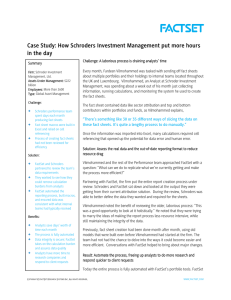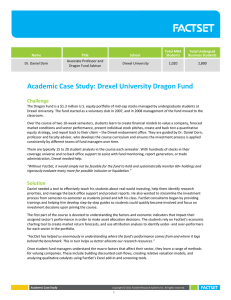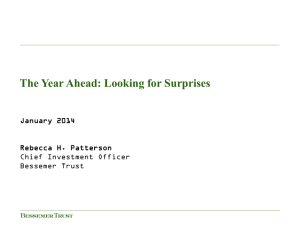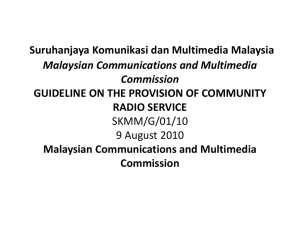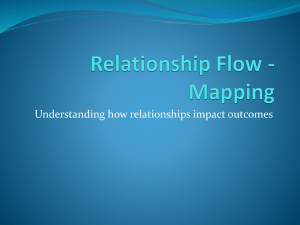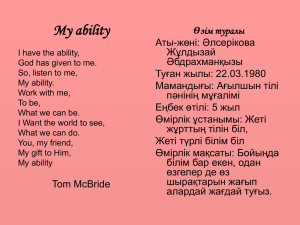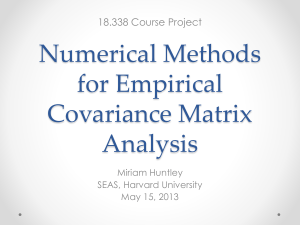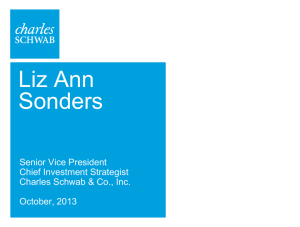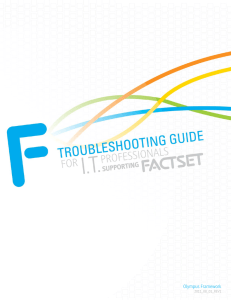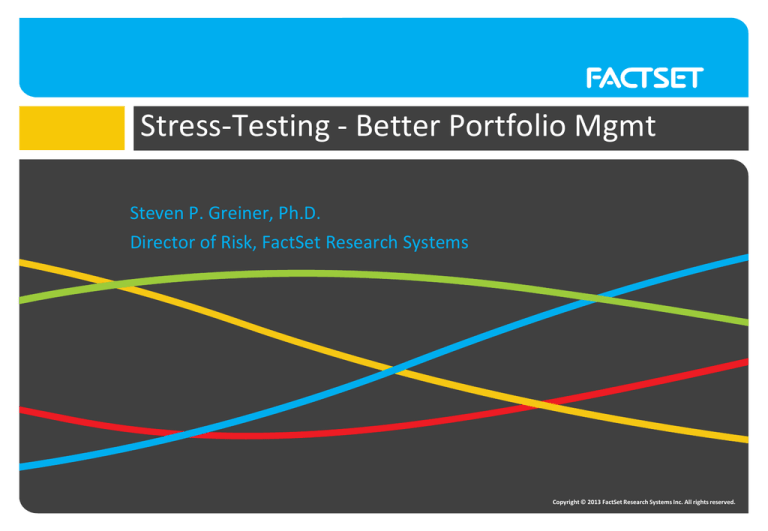
Stress-Testing - Better Portfolio Mgmt
Steven P. Greiner, Ph.D.
Director of Risk, FactSet Research Systems
Copyright © 2013 FactSet Research Systems Inc. All rights reserved.
Agenda
• Why do Stress-Testing? Governance, that’s why!!
• Extreme-Event Stress-Testing
• Going Non-Linear: Markov-Chain MC
• Conclusions
2
Governance – Ethics – Survey Results
+ We are painfully aware of the public opinion towards the financial
sector in the wake of continued financial crisis
3
PRESENTATION FROM FACTSET RESEARCH SYSTEMS
Extreme Event
Stress-Testing
Practical Example
4
Some Stress-Testing Methodologies
EXTREME EVENT
1) Begins with a risk model, you need some way of estimating
correlations (covariance) across assets
2) Obtain the covariance (or factor returns) from some historical
“stressed” market environment or your own innovation
3) Use this covariance to compute risks &/or these factor returns to
compute returns on today’s portfolio
5
All data and charts sourced from FactSet Research Systems Inc.
You run a risk report and see the VaR
increase over the last several weeks
and you think..............
Risk = <w*E*C*Et*wt> + <w*V(ε)*wt>
Is this risk level change caused by trades
(w), exposure changes (E), or market
volatility (systemic risk) itself (C)?
6
Observations
+ 1
1/17
+ 2
1/24
+ 3
1/31
+ 4
2/7
+ 5
2/14
+ 6
2/21
+ 7
2/26
7
Recipe to Interpret Effects
• Select several sequential weekly time periods
• Compute 95% VaR using all the combinations of actual
portfolios, frozen portfolios (i.e. exposures) & covariance on
those dates
• Choose 7 weeks: one obtains a 7 X 7 matrix of exposure
changes on one axis & covariance changes on the other
8
All data and charts sourced from FactSet Research Systems Inc.
Recipe to Interpret Effects
• When exposures are fixed &
covariance evolves, one observes
impact of changing correlations
• Covariance follows VIX
• Allows observation of volatility
impact
9
All data and charts sourced from FactSet Research Systems Inc.
Recipe to Interpret Effects
• When covariance is frozen &
exposures change, one observes
pricing impact
• prices detached from VIX
• Implies exposure change causes
increase in risk
10
All data and charts sourced from FactSet Research Systems Inc.
Recipe to Interpret Effects
• Move further out to 99%
Value-at-Risk
• Even stronger affect out in
the tail
• Exposures dominating
11
All data and charts sourced from FactSet Research Systems Inc.
Recipe to Interpret Effects
• Monitor difference between 99%
and 95% VaR
• Observe tail widening over time
• Though VIX muted..??
• Exposures increasing risk though
volatility is stable
12
All data and charts sourced from FactSet Research Systems Inc.
Conclusions...What’s Happening is...
• Current 95% VaR is increasing mildly =>
• Covariance isn’t resulting in the increased risk =>
• VIX volatility signals are subdued =>
• Rising tail risks are due to exposures changes
(spreading of difference between 99% & 95% VaR) =>
Implies increasing probability of event risk
Q for PM’s: WOULD YOU DO ANYTHING?
13
All data and charts sourced from FactSet Research Systems Inc.
Markov Chain-MC
Stress-Testing
Practical Example
14
Correlations of “Stresses” with S&P100
Drawback? Correlations tie directly
to linear stress-testing
15
Some Stress-Testing Methodologies
MARKOV-CHAIN MONTE-CARLO
1) Begins with a risk model, you need some way of estimating correlations across
assets. Use when your subject to data starvation for tail estimates
2) Generate synthesized data that matches joint probability distribution between the
stress & all risk model factors...simultaneously...to populate the tail
3) Calculate the “beta(s)” between stress & risk model factors:
Factor = beta1*stress + beta2*stress2 + others
4) For a given stress (i.e. -30%), compute a value of F given the applied stress &
compute return estimate
16
All data and charts sourced from FactSet Research Systems Inc.
Markov Chain Monte-Carlo (MCMC)
• Generates sequence of random variables from
an “unknown” multi-variate probability density
while incorporating the correlations from each
variable with every other
• Sequential values tend to be auto-correlated,
so delete early trials
• Optimize the search width parameter to
achieve ~25% acceptance ratio
• Especially useful for re-populating “tail” density
• However, it requires “trial” density???
17
Use “Normal Projection” to create easy trial density
18
Multivariate Weibull Distributions for Asset Returns: I
Yannick Malevergne & Didier Sornette; Finance Letters, 2004 2(6), 16-32
Consider Bi-Modal Multi-Variate MCMC Example
Empirical Pairs Plots (500x5)
MCMC Replicates (2500x5)
QA: Run Kolmogorov-Smirnov 2-sample test that measures whether “x” and “y” are drawn from same distribution
19
Empirical Scatter Plot
Close Up
MCMC Reproduction
20
EURUSD joint with Risk
Model Factors
21
MCMC
EURUSD
Forex
KolmogorovSmirnov
p-value is typically
order of ~65%
22
MCMC
JPYUSD
Forex
23
MCMC
Wheat
Futures
24
MCMC Results allow for Non-Linear ST
25
Cooliolusions!
Stress-Testing is good “Governance”
• Should be part of the investment process and requires
cooperation between RM & PM
• Use it to complement traditional risk measures and to deploy
your own insights
• Shouldn’t solely be based on naive inputs alone. Let your inner
“Michelangelo” out, and be creative with it
FactSet offers complete system..
26
…more examples
27

